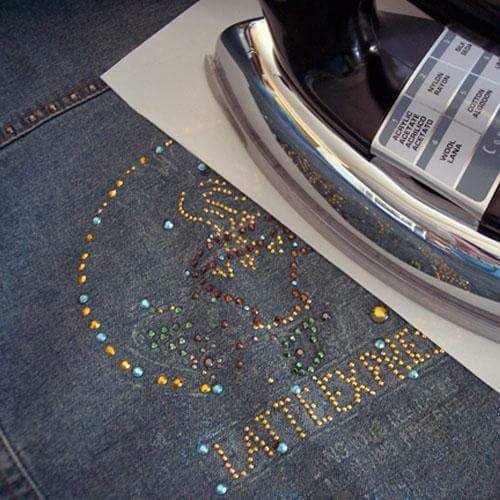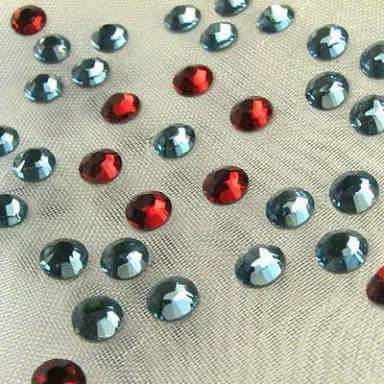Stone/Crystal Application?? Apply with Iron or Heat Press
Fellow steemians for many of us who like to fix stones and crystals to our fabrics but probably don't know how to go about it. Therefore follow me as I explain in detail how you can do it successfully by yourself. Also endeavors to Upvote and RESTEEM this post. Thanks @tybello
Stone/Crystal Application?
Apply with Iron or Heat Press 
Which do I need ?
Heat Press - Unless you are doing production work, you probably don't need a heat press. But, if you have access to a heat press, use it. If not use a household iron. Use the same procedure as below and follow directions provided by the heat press manufacturer.
Dry Iron - A dry iron without heat vents is best. If your iron has vents insert a Telfon (aka PTFE) sheet between the iron sole plate and the fabric. For very small transfers, you can even use the BeJeweler with a Cluster tip.
The Prep...
You only get one chance to do it right so figure out exactly where you want the design. Try on clothing and mark with pins or chalk if necessary.
Place your fabric on a hard, flat and heat proof surface. An ironing board with a Teflon surface is great. If you use a wood table, the heat may damage the wood. You can use a granite or any similar non-porous surface.
NOTE: if your fabric is thin, place a Teflon sheet between the front and back layers / same with pockets. Otherwise the glue will melt and adhere layers of your fabric together. I've done it, it sucks.
The Iron...
Swarovski hot fix glue is activated within a temperature range of 120°C to 170°C (250°F to 340°F). Irons usually have temp chart for the type of fabric you are ironing. Personally I use the temperature for my fabric.
Preheat the iron. Turn off the steam - please.
Press your item before you apply the transfer. It will remove wrinkles and prepare your fabric for the hot fix glue.
The Transfer...
FYI - that clear sticky film (think Scotch tape) holds your crystals in place. Don't mess with it! Peel off the solid plastic (usually white) backing and toss.
Place the film (sticky side with crystals) onto your fabric, exactly where you want the design. You should now be looking through the sticky film and seeing the back of the crystals.
Design not in the perfect spot? No problem, gently lift up the film and put it in the right place.
If your iron has vents, place a Teflon sheet over your transfer.
The iron (again)...
Place your pre-heated iron directly on the Teflon. Allow it to remain in place for at least a minute or two.
If your iron has vents, lift (don't slide) and place over any areas that was under the steam vents. If the transfer is larger than the sole plate of your iron, lift the iron and place on another section of the transfer.
Repeat until you have "ironed" the entire transfer area.
The Cool Down...
Allow the transfer to cool to your touch.
Very slowly peel the clear film off the design. If any crystals are still on the film, place that section of the design back down on the fabric and re-press. I cut away the film where the crystals have adhered to the fabric and place down just the film that crystals are still on.
Allow the transfer to cool again, then slowly peel off the film.
To make sure all crystals are firmly in place, turn the garment inside out and press briefly from the back of the fabric.
The Final Test...
After the fabric cools, run your fingers over the rhinestones. If any seem loose, apply the iron to that area again.
What fabrics are not suitable to for hot fix?
Very tightly woven textiles - canvas for example (but you can "rough up" the surface with a finger nail file or sandpaper so the glue can grab the fibers).
*Hydrophobic or water-repellent treatments (silicone, synthetic resin as a waterproofing agent)
Teflon coatings – stain-resistant treatments – easy-to-care treatments – fluorocarbon finishes
– softening agents – select dyes (dyes with metal pigments) – enzymatic treatments Special care needs to be taken on very thin fabrics, e.g. organza and application on these types of materials is not always recommended.
*NOTE: Test an item by putting a few drops of water on the surface - if it runs off the surface it won't work with glues. Try roughing it up with sandpaper and retest, if the water sinks in, you should be able to apply hotfix crystals. Even then try a few to make sure you're happy with the results.
It can sometimes be helpful to wash the material before application, in order to remove any unsuitable finishes (particularly softening agents), and thus improve absorbency.
Please visit Creative Crystal's website for more image source from Google
image source from Google
Resteemed your article. This article was resteemed because you are part of the New Steemians project. You can learn more about it here: https://steemit.com/introduceyourself/@gaman/new-steemians-project-launch
When it comes to applying stones or crystals to fabrics, several different methods can be used. Some people prefer to use an iron, while others prefer to use a thermal press.
If you are considering using a heat press, it is important to choose the right machine for your needs. This article may be helpful for you in this case https://amstransfers.com/page/blog/the-best-heat-press-machines-for-crafters-small-business . Personally, I have used a thermal press to apply rhinestones to t-shirts and other fabrics. I have found that using a thermal press allows for more precise control of temperature and pressure, which can lead to a more uniform and durable application.